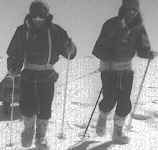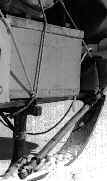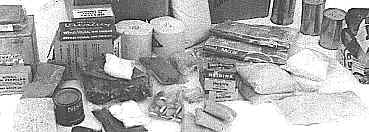 Evan and John haul their 300 kg sledge.
Evan and John haul their 300 kg sledge.
A mile an hour (1˝ kph) is a brisk pace on the flat.
Uphill man-hauling is slower and exhausting.
Alan Beck of the 1957-58 Tucker Glacier Expedition
said of man-hauling:
"Shut yourself off from the world,
and heave each step in a trance.
Don't count minutes or watch the country,
as both pass so slowly."
![]()

 Lunch break from man-hauling. 10 December.
Lunch break from man-hauling. 10 December.![]()

 The sledge carried a 300 kg load:
The sledge carried a 300 kg load:
food, tent, bedding, clothing,
personal items, equipment for
camping, climbing and surveying,
and a radio transceiver.
Norwegian-designed Nansen sledges
have wooden members lashed together,
a resilient construction.
![]()

![]()

![]()
| Back to Antarctica |